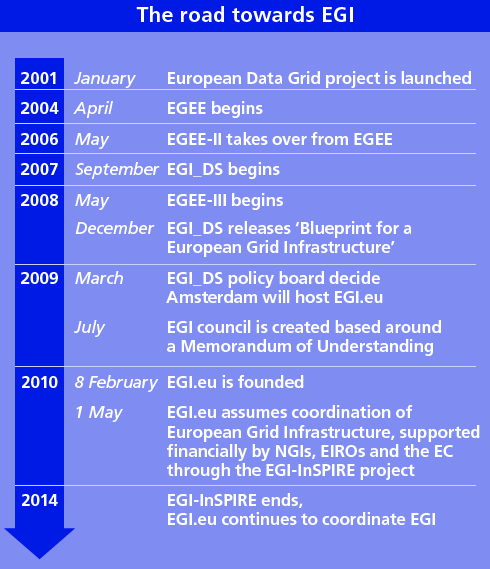EGI
What is EGI?
Video presentation: EGI and e-Infrastructures in Europe(source http://www.egi.eu/)
 On 1 May 2010 EGI took over the coordination of European grid infrastructure. Through the previous DataGrid and Enabling Grids for E-SciencE (EGEE) projects, researchers across the globe reaped the benefits of grid technologies. Now EGI.eu, the organisation established to coordinate EGI, hopes to continue this trend. Although EGI marks a change from short-term funded projects to a long-term service, for the first four years EGI.eu will be financially supported by the European Commission funded project EGI-InSPIRE. EGI will need to develop strong coordination, engage with user communities and forge links with other providers if Europe is to retain its competitive edge in the global landscape of e-Infrastructures.
On 1 May 2010 EGI took over the coordination of European grid infrastructure. Through the previous DataGrid and Enabling Grids for E-SciencE (EGEE) projects, researchers across the globe reaped the benefits of grid technologies. Now EGI.eu, the organisation established to coordinate EGI, hopes to continue this trend. Although EGI marks a change from short-term funded projects to a long-term service, for the first four years EGI.eu will be financially supported by the European Commission funded project EGI-InSPIRE. EGI will need to develop strong coordination, engage with user communities and forge links with other providers if Europe is to retain its competitive edge in the global landscape of e-Infrastructures.
The main objective of the European Grid Initiative (EGI) is to establish a sustainable grid service for the European scientific community, through the creation of a long-term, pan-European grid infrastructure. The European Grid Initiative (EGI) is a partnership between National Grid Initiatives (NGIs), which are responsible for grid infrastructure related matters in each participating country, and a coordinating body, the EGI organisation (EGI.eu), based in Amsterdam. Its central role is to facilitate the interaction and collaboration between NGIs.Within the EGI partnership, NGIs and EGI.eu are thus working together to operate and further develop a sustainable pan-European grid infrastructure, enabling optimal sharing of computing and data resources, and supporting collaborative scientific discoveries in the European Research Area (ERA).
EGI.eu is governed by a Council, which is responsible for providing the long-term direction of the organisation, and the Executive Board, which provides guidance to the Director, who leads the organisation on a day-to-day basis. The EGI Council currently consists of 30 NGI members as well as two EIROforum members. Projects included in the European Strategy Forum for Research Infrastructures (ESFRI) Road Map - the EC’s initiative to develop the scientific integration of Europe and to strengthen its international outreach - are also invited to contribute to, and benefit from EGI, as is any organisation that subscribes to EGI’s objectives.
EGI.eu is funded through membership fees paid by NGIs, with a contribution by the European Commission (EC) for related projects.
What is an NGI?
NGIs are officially recognised bodies that ensure the operation of the grid infrastructures in their own country, and an effective and transparent representation of the needs and wishes of their scientific communities, resource providers and e-infrastructure related institutions. They provide a single point of contact in each country, which is fundamental for efficient coordination between the NGIs, users, resource owners and other interests.
Within the EGI model, NGIs are free to organise and distribute their resources and services among their community as they want. Computing resources continue to be hosted and funded within the member states or the relevant international facilities.
National Grid Initiatives (NGIs) are performing the following tasks
- Authentication of individual users as the people they claim to be.
- Allocation of project or discipline collaboration members to VOs where resources are shared.
- Allocation of computing resources to those VOs which VO members will be authorized to use.
- Authorization of VOs to run computing jobs, store and retrieve data on individual computing resources (machines, data centres, facilities, etc.).
- Distribution and scheduling of computing jobs, workflows, data retrieval and access requests to authorized computing resources.
- Monitoring of the jobs submitted, processed, and the data stored by individuals.
- Accounting of users and VO in their allocations and usage of computing resources.
- Reporting to each NGI of their allocation of resources to VOs, and the use of those resources by individual users, in order to enable the NGI and the national funding bodies to account for the use of funds in terms of the research results produced by VOs.
- Coordinated management of software updates and hardware upgrades while maintaining a continuous service.
- Standards, policies and other consensus accepted by EGI are implemented.
What is ESFRI?
The European Strategy Forum on Research Infrastructures (ESFRI) roadmap projects span social and biomedical sciences, earth and physical sciences, energy, infrastructures and analytical facilities. But despite their variety, the ESFRI projects all have one thing in common: they need to store and analyse vast amounts of data.
In the coming years EGI plans to collaborate with the ESFRI projects, expanding the infrastructure to support these communities. To date, the ESFRI projects are all in different stages of maturity. While some have mapped their storage, data and processing requirements, others are still working towards this. EGI can offer support in a variety of ways, from consultancy to helping the ESFRI projects become expert users of the infrastructure.
